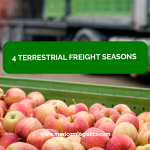Why are freight rates still going up?
Freight rates are still going up in most regions, but especially in America. What is the reason?
The changes that COVID-19 brought into consumption resulted in maritime freight traffic, lack of equipment and staff, besides high operating costs and over the moon oil prices in most of the ports throughout the world. These are the most remarkable causes of the increased freight rates that we have faced in the last months. In this post, we will explain how these reasons are related to each other and what is the role of North America in the context.
Pandemic effects in consumption and the flow of goods
When the COVID-19 pandemic started, together with the first contagions and lockdowns, the global economy collapsed, and freight transportation companies were forced to diminish their capacity. On the other hand, there were drastic alterations in consumption habits and people began to spend more online, mostly on remodeling and home goods.
Due to this, from the third quarter of 2020, there was an unexpected upturn in demand that caused a surprising increase in freight transportation rates, delays, and low equipment availability, which impacted directly the supply chains that go through Asia-Europe and Asia-U.S. Besides, the natural disasters, new contagion waves and the actions to reduce their impact, as well as other setbacks have hampered that the world supply flow goes back to normal and rates to stabilize.
North American market and the low equipment availability
While supply chains have adjusted to take advantage of the offer and meet the demand, global markets have moved back in face of the local ones, who are also suffering from all the implications they face. In some places, the over-abundance of transportation services has caused the price reduction, while the low equipment availability has skyrocketed the prices in the rest of the market. This is what happened in North America. Due to COVID-19 and the commerce restrictions in Asia, the United States local demand has increased and with it, there is a high domestic demand and with it a high request of American businesses established in Mexico.
All this has provoked a freight flow imbalance since trailers are sent up towards the North but do not come back to the origin in the same proportion. They are repurposed in the domestic commodity flow throughout the U.S. territory. This imbalance makes the low equipment availability even worse. In Mexico, for example, there is the need to look for alternatives to fulfill the high exportation demand, which results in the costs increasing.
Demand increase in the U.S. and port traffic
Another matter is that the politics designed by the U.S. government to motivate consumption have provoked a growth of importations in the U.S., which has affected international sea commerce. Ports turned into bottlenecks. Ships have to wait up to three weeks to download the commodities; this price has to be compensated by companies in the increased prices. All of it causes even more equipment shortages.
Lack of workforce
Driver’s shortage has been a problem for the industry in the last years, and it has become even a bigger setback since the pandemic started. Hiring paperwork is now even harder to fulfill, and this has caused a less number of young people to get recruited and that existing drivers face more obstacles to work.
Also, the labor conditions, the long hours, the road insecurity, and the low salaries are far from being great, not to mention the high risk of contagion that it involves. All of this makes the job less appealing, and it is why a lot of drivers have chosen to look for positions in the building industry or the last-mile deliveries.
There is not only a lack of drivers but also stevedores, warehouse employees, and some other positions. The reasons for this shortage are similar to the ones we mentioned before.
Operating costs
The maintenance expenses for the equipment rise by the day. Investing in new vehicles, compounds, and automatization to correct the lack of capacity, as well as the need to get accident insurance, results in even more costs. As a consequence, the freight transportation companies have to increase their rates to fulfill these operating costs.
Outlook for freight transportation rates
It seems that supply chains will not stabilize before the end of 2022. In the meantime, holidays are near and with them another modification in demand, this means that the chains will be stressed out and will suffer another increment.
Besides this, companies will continue searching for strategies to compensate for the losses and keep working. This can be translated into service limitation, less efficiency, strict service hiring, etc. Working with a 3PL like Mexicom Logistics can make a difference in the face of these obstacles. Our experience, tools, and connections allow us to provide options according to the budget to let your business go forward in the best way.










Pretty nice post. I just stumbled upon your weblog and wanted to say that I have really enjoyed browsing your blog posts.
After all I will be subscribing to your feed
and I hope you write again very soon!